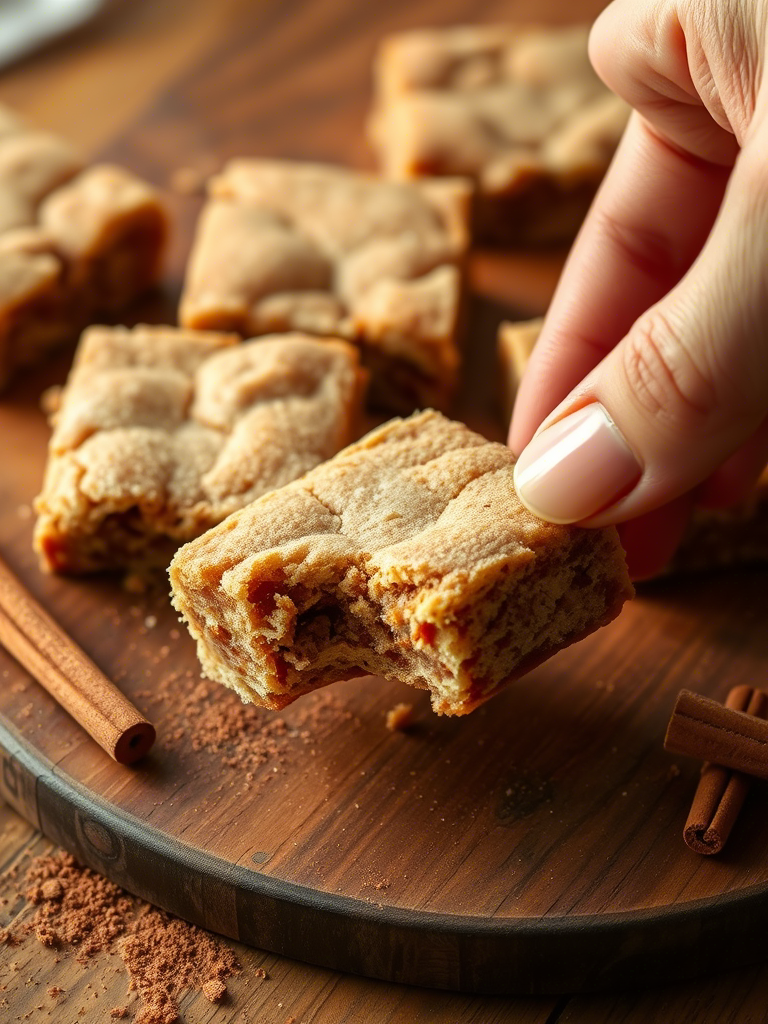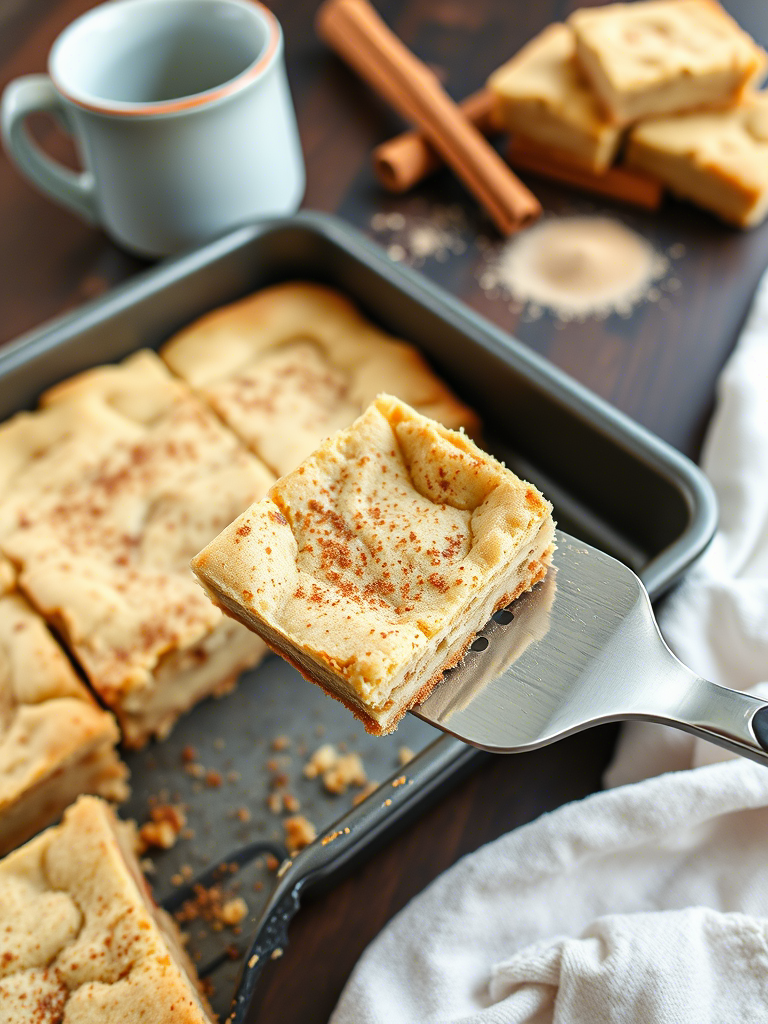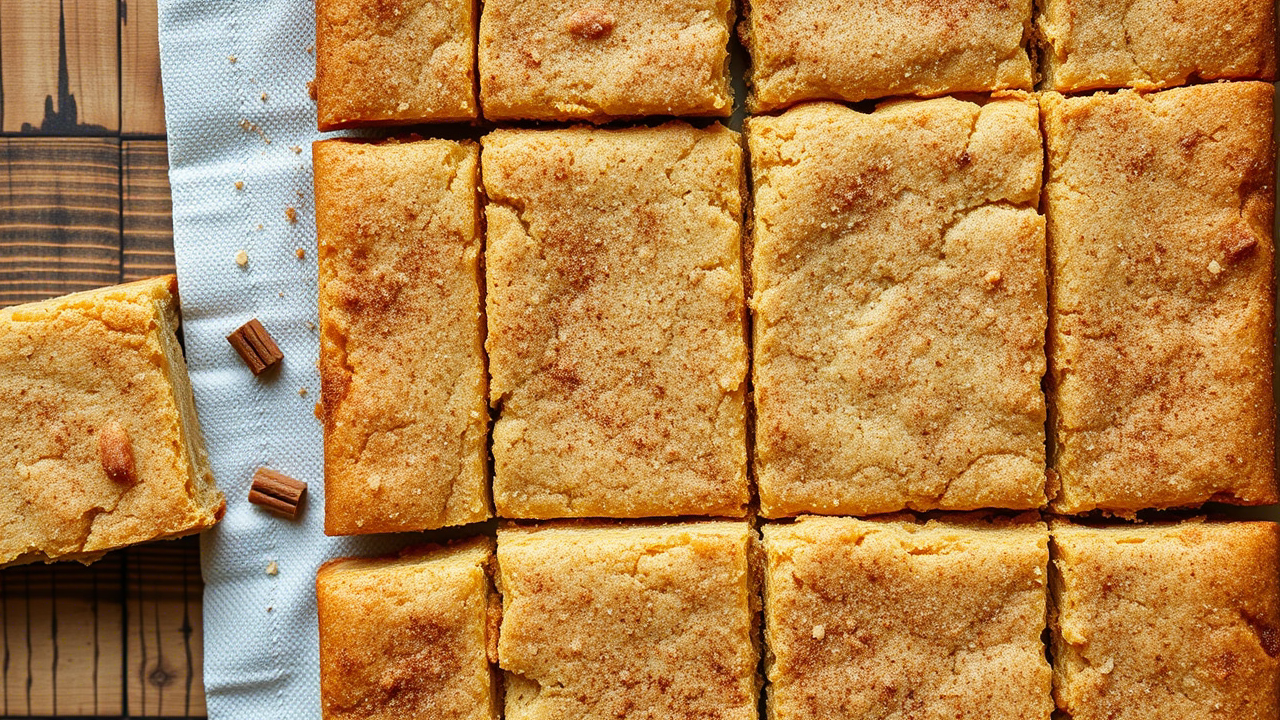You ever bite into something that feels like your childhood just got a promotion? That’s the chewy snickerdoodle cookie bar. It’s got that nostalgic cinnamon-sugar hug, but in a form that plays better on bakery trays, bulk orders, or high-yield service lines. We’re not talking dainty little cookies here—we’re talking plush, chewy, unapologetically rich bars with a crackly top and a whisper of tang.
These aren’t your grandma’s snickerdoodles (though she’d definitely swipe the recipe). For professionals—pastry chefs, bakery owners, culinary instructors—this is the evolution of a classic. An efficient, scalable, crave-worthy alternative that doesn’t skimp on flavor or texture. Let’s dig into the anatomy, science, and soul of chewy snickerdoodle cookie bars, and see why they’re earning their keep in both test kitchens and commercial menus.
Why Bars, Not Cookies?
Efficiency. Texture. Shelf life. And maybe a touch of laziness.
Cookie bars skip the scoop-and-roll step, which matters when you’re scaling production. One 9×13 pan = 24 pieces, no portioning drama. Plus, you get those coveted chewy edges and that soft, thick center—consistently. Snickerdoodle cookies often bake unevenly, dry out fast, or end up too puffy. Bars hold moisture. And that tangy-creamy bite lingers longer when baked in bar form.
Also: they freeze better. They reheat like a dream. And they stack neatly in packaging, which is a logistical win if you’re moving product at markets or cafés.
The Tang Factor: It’s Not Just Cream of Tartar
Let’s settle this right now. Cream of tartar isn’t just “for flavor.” It’s crucial for structure.
It’s potassium bitartrate—a byproduct of winemaking—that acidifies the dough. Combined with baking soda, it creates carbon dioxide, which gives the bars that lift without puff. But the acid also interrupts gluten formation just enough to soften the crumb. This is key. You want chewy, not cakey. Soft, not floppy.
Some folks try to sub lemon juice or vinegar. That’s cute. But it’s not the same. Cream of tartar imparts a specific, almost imperceptible tang that screams “snickerdoodle” to anyone who grew up with one in hand. Swap it out, and you’ve lost the soul of the thing.

Butter, Brown Sugar, and the Magic of Moisture Control
Fat is flavor, sure. But fat is also water management.
Most snickerdoodle cookie bars thrive on a 1:1 butter to sugar ratio—by weight, not volume. But here’s where the pros separate from the pack: don’t use all white sugar. A 60/40 split, leaning toward brown sugar, keeps the interior moist and chewy for days. The molasses in brown sugar is hygroscopic—it grabs and holds water like a greedy little sponge.
Unsalted butter, room temp. Melted butter tends to create denser bars, which works if you want that blondie-adjacent texture. But for a layered crumb—light on top, dense in the middle—softened butter is your friend.
Also, use European butter if you can. Higher fat content. Deeper flavor. And less water, which means less steam, which means less risk of cake-like lift.
Flour Matters More Than You Think
All-purpose is the standard. But even within AP flour, protein levels vary. Gold Medal’s AP is 10.5% protein; King Arthur’s is closer to 11.7%. That’s a big difference when you’re chasing chew.
Lower protein means less gluten, which means a more tender bar. For chewy snickerdoodle bars, aim for 10–11% protein flour. If you’re stuck with higher-protein flour, cut 10% of it with cake flour or cornstarch. Works like a charm. Texture control is everything.
Pro tip: don’t overmix. Once the flour goes in, stir just to combine. Overworking the dough = tough, sad bars. You’ve been warned.
Cinnamon Isn’t Just Spice—It’s Strategy
Cassia vs. Ceylon. Most recipes don’t tell you which cinnamon to use. But if you’re making something where cinnamon is 40% of the flavor profile, it’s worth thinking about.
Cassia (the standard grocery store stuff) is bold, warm, and slightly spicy. Ceylon is more delicate, citrusy. For cookie bars, cassia works best. You want that upfront, in-your-face warmth. But blending the two? That’s next-level. Use cassia in the sugar crust and a pinch of Ceylon in the dough for complexity.
And please, toast your cinnamon. Just 30 seconds in a dry pan before mixing it with sugar. It intensifies the aroma and takes off the raw edge. Nobody ever regrets that step.
Eggs, Yolks, and the Custard Principle
Eggs are more than binders. They’re emulsifiers, leaveners, and fat providers. A whole egg adds structure. A yolk adds richness. Want a bar that eats like a soft-baked cookie but holds like a brownie? Use 2 whole eggs + 1 yolk per standard batch (about 2 cups of flour).
Too many eggs = rubbery texture. Too few = crumbly. The ratio matters.
Also: room temperature. Cold eggs seize butter. And if you add cold eggs to a partially creamed base, it breaks the emulsion. Then you’ve got greasy dough and patchy rise.

Mixing, Resting, Baking: Where It All Comes Together
Cream the butter and sugars for at least 2 minutes. You want air. Not too much, though—these aren’t cupcakes. Then add eggs one at a time. Scrape the bowl. Yes, always. If you skip scraping, you’re asking for uneven bake and textural weirdness.
After mixing in the dry ingredients, rest the dough. Even 30 minutes helps. It hydrates the flour, mellows the flavors, and makes for a smoother spread in the pan.
Press into a greased or parchment-lined pan—don’t overpack. Sprinkle cinnamon sugar generously on top. It forms that thin, crackly crust. Bake at 325°F, not 350°F. Slower bake = moister center. Rotate the pan halfway through. Most ovens lie.
Pull them when the edges are golden and the center is just barely set. Slight jiggle is good. Overbaking is death.
Storage, Freezing, Reheating—Yes, It Matters
Cool completely before slicing. Warm bars fall apart. Wrap tightly. They keep for 4–5 days at room temp. Freeze up to 2 months. Defrost overnight. Reheat at 300°F for 5 minutes to restore that just-baked feel.
You can even serve them warm with cinnamon ice cream or dulce de leche. They hold up.
From a service perspective, they’re a dream. Consistent portions. High yield. Low waste. High profit margin. And they play nice with a dozen other flavors. You can riff with cardamom, white chocolate chunks, browned butter, even tahini. But at their core, they’re still snickerdoodle.
Common Missteps (And How Not to Fall Flat)
Mistake #1: Overbaking. Leads to dry, cakey bars. Use a timer. Use your eyes. Trust the wobble.
Mistake #2: Skipping cream of tartar. Then wondering why they just taste like cinnamon sugar blondies.
Mistake #3: Using cold ingredients. Cold butter doesn’t cream. Cold eggs ruin emulsion. Room temp is rule #1.
Mistake #4: Wrong pan. Glass pans insulate differently than metal. Use a light-colored metal pan for even heat.
Mistake #5: Cutting too soon. Let them cool. Not optional. Patience makes pretty bars.
A Peek Into Commercial Kitchens: Why They Work So Well
In foodservice, the snickerdoodle cookie bar solves problems.
Prep time? Minimal. Holds well on pastry trays. Great for grab-and-go. Works in school lunches, airline catering, box lunches, cafes. Easy to scale. And cinnamon is universally appealing, low cost, high impact.
Data from Technomic shows cinnamon-based bakery goods grew 8.7% in menu presence over the past three years. Consumers want “comfort” but elevated. Snickerdoodle bars check both boxes.
Even better? You can sell them year-round. No seasonal boundaries.
Final Thoughts: What Makes a Snickerdoodle Bar Great?
A great snickerdoodle cookie bar has contrast. Crisp top. Chewy middle. Tangy-sweet flavor. It’s nostalgic, but not basic. It should feel handmade, even in a commercial setting. It should smell like home and bite like a bakery product.
Professionals, this isn’t just a bake-sale treat. It’s a flexible, profitable, scalable menu item that delivers on flavor, structure, and memory. It’s what happens when tradition and technique stop arguing and decide to work together.
Now go bake some. And don’t skimp on the cinnamon sugar, yeah?
FAQs
ChatGPT said:
What makes snickerdoodle cookie bars different from regular snickerdoodle cookies?
They’re thicker, chewier, easier to scale, and more consistent in texture.
Why is cream of tartar important in snickerdoodle bars?
It adds tang and reacts with baking soda to create the classic chewy texture.
Can I replace cream of tartar with lemon juice or vinegar?
Technically yes, but it won’t taste or behave quite like a true snickerdoodle.
What type of sugar works best for chewy texture?
A mix of brown and white sugar—about 60/40—locks in moisture beautifully.
Should I melt the butter or cream it?
Creaming softened butter gives a better lift and more tender crumb than melted butter.
What’s the ideal flour type for chewy bars?
Low to mid-protein all-purpose flour (10–11%) is best for that soft chew.
Is it necessary to rest the dough before baking?
Yes, resting hydrates the flour and improves texture and flavor.
What temperature should I bake snickerdoodle bars at?
Bake at 325°F for slower, more even cooking and moist centers.
How do I know when the bars are done?
The edges should be golden and the center just barely set with a slight jiggle.
What’s the best way to store snickerdoodle bars?
Wrap tightly and keep at room temp for up to 5 days or freeze for 2 months.
Can snickerdoodle bars be reheated?
Yes, 5 minutes at 300°F revives them like magic.
Do these bars hold up in commercial foodservice settings?
Absolutely—they’re reliable, cost-effective, and wildly popular across demographics.
Can I customize the flavor profile?
Totally—try cardamom, brown butter, white chocolate, or even tahini for a twist.
Why toast the cinnamon before use?
It boosts aroma and removes any harsh, raw spice notes.
What kind of pan works best for baking?
Use a light-colored metal pan for even baking and clean edges.
What’s the biggest mistake to avoid?
Overbaking—dry, cakey bars are nobody’s favorite.

Mariana is a passionate home cook who creates delicious, easy-to-follow recipes for busy people. From energizing breakfasts to satisfying dinners and indulgent desserts, her dishes are designed to fuel both your body and hustle.
When she’s not in the kitchen, she’s exploring new flavors and dreaming up her next recipe to share with the Foodie Hustle community.

